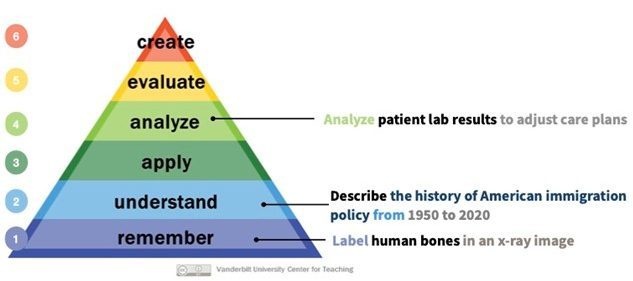Academic programs at the University of Missouri are required to have specific and measurable program outcomes that define what students should know or be able to do by the end of their program. This guide is intended for programs seeking to create or revise their program outcomes.
What Do You Want Your Students to Know 5 Years from Now?
Envision encountering one of your students 5 years from now. You begin speaking of your program. Ask yourself: What do you wish this student retained from your program?
When we ask this question of faculty, disciplinary tidbits and other negligible skills tend to fall away, replaced with observable skills and relevant content knowledge. This insight is a good place to start when creating or revising program outcomes.
What Does Alignment Mean?
Alignment refers to the ability of a program to articulate how its structure is built upon a series of outcomes and course learning objectives. We can define program outcomes as the skills/knowledge gained from a program and course learning objectives as skills/knowledge gained from a course. We can continue with module, unit, or weekly learning objectives as skills/knowledge gained from that module/unit/week.
A program is considered aligned if the program’s outcomes are met across a collection of courses (via course learning objectives, learning activities, and assessments). An aligned program is one in which any course learning objective, Activity, or Assessment explicitly connects to at least one program outcome.
What are Effective Program Outcomes?
Effective program outcomes have the following characteristics:
- Program outcomes are relevant to the discipline. Program outcomes should be tailored to meet the specific needs of the discipline, ensuring students are gaining skills and knowledge essential to the field.
- Program outcomes are clear and measurable. Program outcomes are written to be assessed (i.e., we can identify if a student has achieved that outcome).
- Program outcomes are flexible to diverse teaching methods. Program outcomes are written to accommodate a variety of teaching and learning approaches (i.e., there are multiple ways to teach to the outcome).
Recommended Format for Writing Program Outcomes and Course Learning Objectives
Whether we’re writing program outcomes, course learning objectives, or module/unit/week learning objectives, the format is identical. Our recommended format is:
| Recommended Format | Action Verb + Noun (+condition + timescale) |
When grounded in a learning taxonomy, this format ensures that we keep rigor and assessment in mind.
Examples across the discipline include:
- Analyze Freedom House data in Excel.
- Label human bones in an x-ray image.
- Describe post-treatment care to a patient during an office visit.
- Describe the history of American immigration policy from 1950 to 2020.
- Critique a SWOT Analysis in the tech sector.
- Identify different rhetorical strategies in multidisciplinary texts used in the course.
(Adapted from USC Center for Teaching and Learning, 2023)
Whether program outcomes, course learning objectives, or module/unit/week learning objectives, each statement is prefaced by a verb, followed by a noun and any conditions or timescales. Following this format ensures that the statements can be assessed.
Using a Learning Taxonomy
Grounding program outcomes in a learning taxonomy helps in by (1) ensuring outcomes are clear and measurable; (2) aligning outcomes with larger goals; (3) providing a framework for assessment; and (4) guiding instructional strategies.
Bloom’s Revised Learning Taxonomy is a recognized learning taxonomy and the recommended taxonomy for academic programs. By organizing outcomes into six progressive cognitive levels—remember, understand, apply, analyze, evaluate, and create—it ensures a comprehensive approach to learning that facilitates both foundational knowledge acquisition and the development of higher-order thinking skills. This categorization aids faculty in designing curricula that enhance students’ abilities from basic recall of information to creative problem-solving.
When we add the outcomes/objectives listed above, we see the variety of rigor:

Note that labeling human bones in an x-ray image could be at the lowest level of rigor in Bloom’s taxonomy; describing the history of immigration policy across a series of decades is more rigorous; analyzing patient lab results to adjust care plans is more rigorous than labeling or describing, thus it’s placed at the analyze level.
While we recommend Bloom’s Revised Taxonomy, academic programs may want to consider learning taxonomies, including:
- Fink’s (2003) Taxonomy of Significant Learning
- Marzano and Kendall’s (2007) New Taxonomy of Educational Objectives
Recommendations to Programs Writing or Revising Program Outcomes
In addition to following the formula above, programs should consider the following recommendations:
- Review and adapt existing outcome sets. Outcome sets from initiatives and accrediting bodies can inspire or streamline the review or development of program outcomes. We recommend reviewing sets like the National Association of Colleges and Employers (NACE) for a well-vetted set of outcomes.
- Keep to 10 or fewer program outcomes. We advise limiting program outcomes to no more than 10 items. This simplifies the mapping process between course learning objectives and program outcomes, ensuring a streamlined and manageable approach to curriculum design and assessment.
Assistance
For assistance in any aspect of writing program outcomes, please reach out to Jonathan Cisco, Director of Educational Assessment.